Standards Worldwide
Standards Worldwide
Phone +49 30 58885700-07

Standard [CURRENT]
ASTM E 1077:2014
Standard Test Methods for Estimating the Depth of Decarburization of Steel Specimens
- German title
- Verfahren zur Ermittlung der Entkohlungstiefe von Stahlproben
- Publication date
- 2014 reapproved: 2021
- Original language
- English
- Pages
- 10
- Publication date
- 2014 reapproved: 2021
- Original language
- English
- Pages
- 10
- DOI
- https://dx.doi.org/10.1520/E1077-14R21
Product information on this site:
Quick delivery via download or delivery service
Buy securely with a credit card or pay upon receipt of invoice
All transactions are encrypted
Short description
1.1 These test methods cover procedures for estimating the depth of decarburization of steels irrespective of the composition, matrix microstructure, or section shape. The following basic procedures may be used: 1.1.1 Screening methods. 1.1.2 Microscopical methods. 1.1.3 Microindentation hardness methods. 1.1.4 Chemical analysis methods. 1.2 In case of a dispute, the rigorous quantitative or lineal analysis method (see 7.3.5 and 7.3.6 ) shall be the referee method. These methods can be employed with any cross-sectional shape. The chemical analytical methods generally reveal a greater depth of decarburization than the microscopical methods but are limited to certain simple shapes and by availability of equipment. These techniques are generally reserved for research studies. The microindentation hardness method is suitable for accurate measurements of hardened structures with relatively homogeneous microstructures. 1.3 The values stated in SI units are to be regarded as standard. No other units of measurement are included in this standard. 1.4 This standard does not purport to address all of the safety concerns, if any, associated with its use. It is the responsibility of the user of this standard to establish appropriate safety and health practices and determine the applicability of regulatory limitations prior to use.
ICS
77.080.20
DOI
https://dx.doi.org/10.1520/E1077-14R21
Also available in
Loading recommended items...
Loading recommended items...
Loading recommended items...
Loading recommended items...
